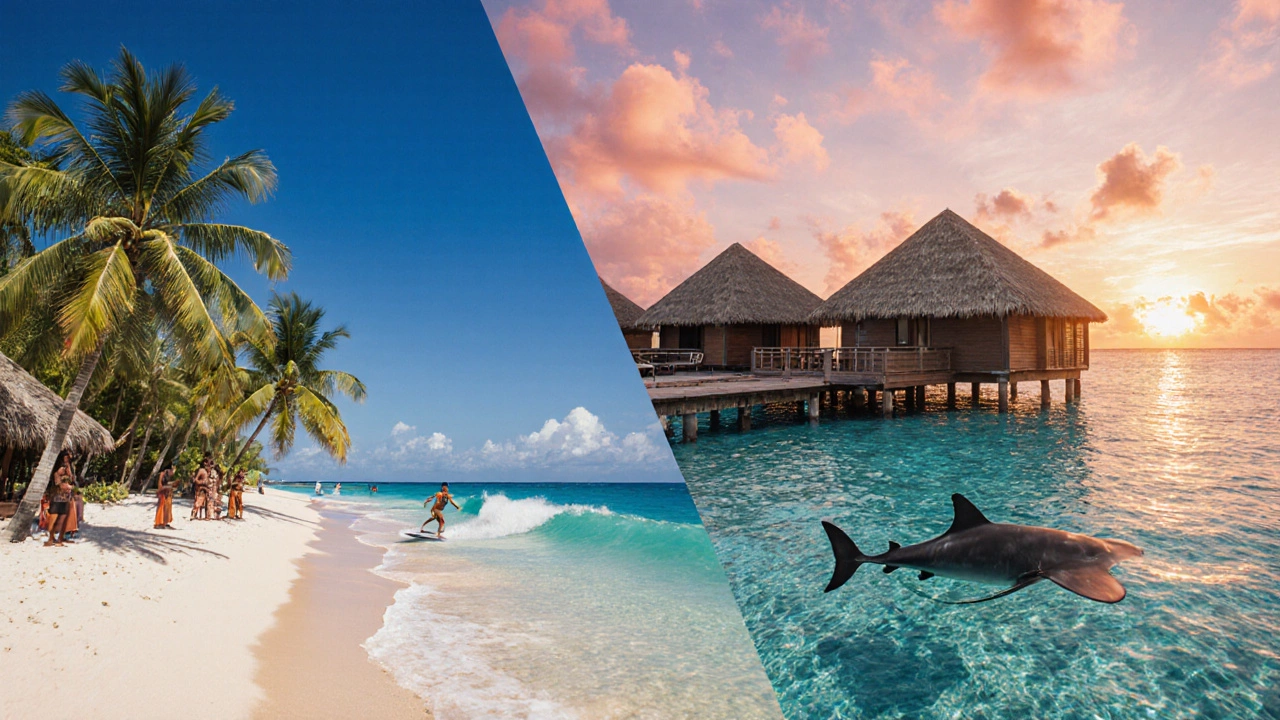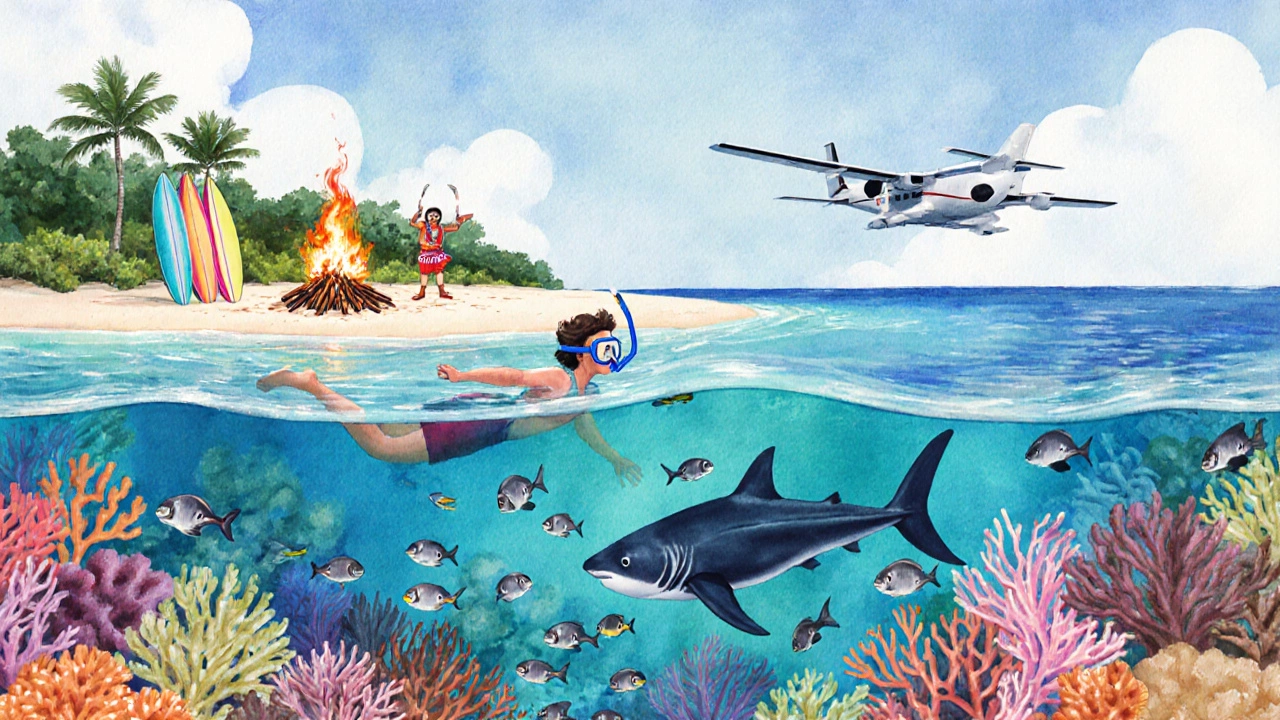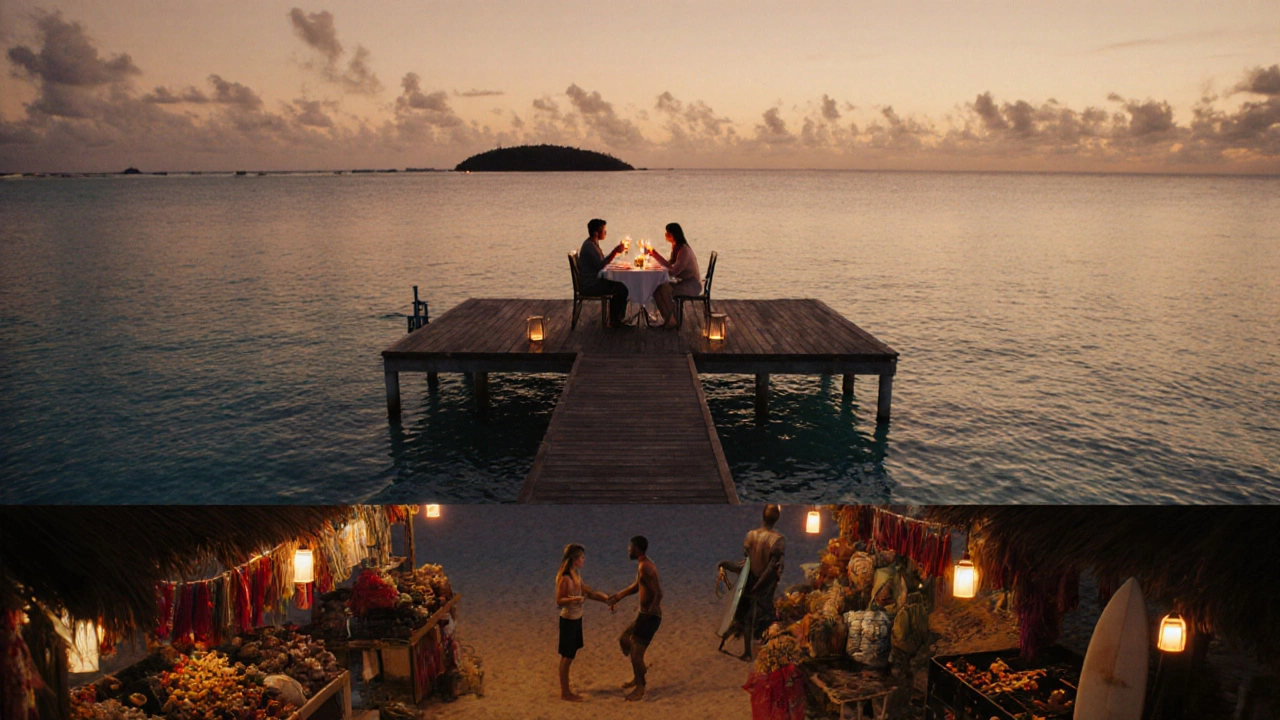Fiji vs Maldives: Which Beach Paradise Wins?
 Oct, 16 2025
Oct, 16 2025
Fiji vs Maldives Budget Calculator
Estimate Your Trip Costs
Compare expenses for your dream beach vacation. Enter your preferences to see realistic cost ranges.
When travelers talk about Fiji is a South Pacific archipelago of 330 islands known for turquoise lagoons and vibrant marine life, the image that pops up is one of palm‑fringed beaches, soft white sand, and laid‑back island vibes. Maldives is a sprawling Indian Ocean nation of 1,200 coral islands famous for over‑water bungalows and crystal‑clear waters evokes a similar picture, but the two destinations differ in culture, cost, activities, and even the feel of the sea.
Why the comparison matters
Both Fiji and the Maldives dominate lists of dream beach getaways, yet your ideal vacation might hinge on budget, travel time, or the type of experience you crave. By breaking down the main elements-flight logistics, accommodation styles, best travel seasons, water activities, and local culture-you can decide which island chain aligns with your personal travel style.
Getting to know Fiji
Fiji’s main international gateway is Nadi International Airport, which welcomes direct flights from Australia, NewZealand, and a few Asian hubs. Once you land, the most popular island clusters are the Mamanuca Islands a group of 20 small islands famous for surf breaks and luxury resorts. For those seeking authentic Fijian culture, the larger island of Viti Levu offers villages where you can join a traditional kava ceremony or learn a haka‑style fire dance.
Fiji’s climate is tropical year‑round, with a warm, wet season from November to April and a cooler, drier period from May to October. The dry months are prime for snorkeling because of calmer seas and clearer visibility, while the wet season brings occasional cyclones that can disrupt travel plans.
Getting to know the Maldives
The Maldives’ primary entry point is Velana International Airport on Hulhule Island, just a short ferry ride from the capital, Malé. From there, most visitors transfer to resort islands via speedboat or seaplane. The most celebrated resort region is Baa Atoll a UNESCO Biosphere Reserve known for its thriving manta‑ray population and high‑end resorts. Unlike Fiji’s larger islands, most Maldivian resorts occupy a single island, giving you a sense of exclusive privacy.
The Maldives enjoys a warm, humid climate with two monsoon periods: the southwest monsoon (May‑October) brings rougher seas, while the northeast monsoon (November‑April) offers the calmest waters and best visibility for diving.
Side‑by‑side comparison
| Aspect | Fiji | Maldives |
|---|---|---|
| Average Flight Time (from Europe) | ~24hours with one stop | ~20hours with one stop |
| Best Travel Season | May‑October (dry) | November‑April (northeast monsoon) |
| Typical Accommodation Cost (per night) | Budget: $50‑$100; Luxury: $300‑$800 | Budget: $150‑$250 (guesthouses); Luxury: $500‑$2000+ |
| Signature Experiences | Surfing at Cloudbreak, village cultural tours, coral reef snorkeling | Over‑water bungalows, night‑time manta‑ray dives, private island picnics |
| Visa Policy | 30‑day visa on arrival for most nationalities | 30‑day free visa on arrival for most nationalities |
| Travel Infrastructure | Well‑developed domestic flights, ferries, and road network on Viti Levu | Resort‑centric, relies on speedboats/seaplanes; limited public transport |

Who should pick Fiji?
If you love a mix of adventure and culture, Fiji offers more variety beyond the beach. The Coral reefs around Fiji boast over 1,000 species of fish, making it a diver’s paradise, and the islands host world‑class surf breaks like Cloudbreak that attract pro surfers. Families often appreciate the range of budget‑friendly hotels and the ability to explore multiple islands without spending a fortune. Plus, a short hop to the capital allows for city‑side dining and a glimpse of colonial architecture.
Who should pick the Maldives?
The Maldives is tailor‑made for romance, privacy, and ultra‑luxury. If you envision waking up in an over‑water villa, stepping onto the lagoon for a private breakfast, or diving with manta rays in a protected marine park, this archipelago delivers. Honeymooners and couples often choose the Maldives for its seamless resort experience-everything from spa treatments to gourmet meals is on‑site. The trade‑off is a higher price tag and fewer opportunities to mingle with local communities, as most resorts are isolated.
Practical planning tips
- Book early for peak season: Both destinations fill up fast during their dry periods. Secure flights and hotels at least six months ahead.
- Consider a mixed itinerary: Fly into Fiji, spend a week island‑hopping, then transfer to the Maldives for a luxury finish. Though logistically complex, it offers the best of both worlds.
- Check health requirements: Both locations require standard travel vaccinations; the Maldives may ask for a negative COVID‑19 test depending on global conditions.
- Pack reef‑safe sunscreen: Both Fiji and the Maldives protect their Coral reefs sensitive ecosystems that can be damaged by chemicals in traditional sunscreen. Choose mineral‑based options.

Common pitfalls and how to avoid them
One mistake travelers make is assuming the Maldives is always the more expensive choice. Guesthouses on local islands can be surprisingly affordable, offering a glimpse of Maldivian life without the resort price. Conversely, some visitors think Fiji is always cheap; resort islands like the Mamanucas can command rates comparable to Maldives luxury properties. Always compare accommodation tiers rather than assuming a blanket price.
Another slip is overlooking travel time. While the flight durations are similar, Fiji’s internal travel often requires ferries or short domestic flights, adding extra hours. The Maldives’ resort transfers can be lengthy too, especially if you need a seaplane ride during peak sunrise slots. Build buffer days into your itinerary.
Final thoughts
Both Fiji and the Maldives are world‑class beach destinations, but they cater to different travel personalities. Choose Fiji if you crave cultural immersion, diverse island experiences, and a range of budgets. Opt for the Maldives if your priority is unrivaled luxury, privacy, and marine wildlife encounters in a compact, resort‑focused setting. Whichever you pick, you’ll walk away with sun‑kissed memories and a reel of stunning ocean photos.
Frequently Asked Questions
Which island is more budget‑friendly overall?
Fiji generally offers a wider range of budget accommodations, especially on the larger islands and in the Mamanuca group, whereas the Maldives’ lower‑cost options are limited to local island guesthouses.
When is the best time for diving in each destination?
For Fiji, the dry season (May‑October) offers calm waters and high visibility. In the Maldives, the northeast monsoon (November‑April) provides the clearest water and the highest chance of seeing manta rays and whale sharks.
Do I need a visa for either country?
Both Fiji and the Maldives grant a 30‑day visa on arrival for most nationalities, making entry hassle‑free for short vacations.
Can I combine a beach stay with cultural experiences?
Fiji excels at blending beach time with cultural immersion-village visits, traditional ceremonies, and local markets are easily accessible. The Maldives is more resort‑centric, though day trips to local islands can provide a taste of Maldivian culture.
Which destination offers better surf conditions?
Fiji’s Mamanuca and outer islands host world‑renowned surf breaks like Cloudbreak and Restaurants, making it a top choice for surfers. The Maldives has surf spots, but they’re less consistent and generally suited for intermediate riders.